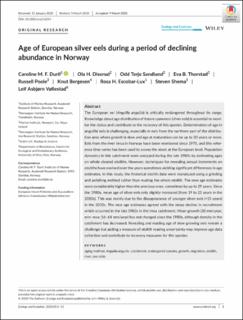Age of European silver eels during a period of declining abundance in Norway
Durif, Caroline; Diserud, Ola Håvard; Sandlund, Odd Terje; Thorstad, Eva Bonsak; Poole, Russell; Bergesen, Knut Aanestad; Escobar-Lux, Rosa H.; Shema, Steven; Vøllestad, Leif Asbjørn
Journal article
Published version

Åpne
Permanent lenke
https://hdl.handle.net/11250/2651278Utgivelsesdato
2020Metadata
Vis full innførselSamlinger
- Scientific publications [1392]
Originalversjon
10.1002/ece3.6234Sammendrag
The European eel (Anguilla anguilla) is critically endangered throughout its range. Knowledge about age distribution of future spawners (silver eels) is essential to monitor the status and contribute to the recovery of this species. Determination of age in anguillid eels is challenging, especially in eels from the northern part of the distribution area where growth is slow and age at maturation can be up to 30 years or more. Eels from the river Imsa in Norway have been monitored since 1975, and this Reference time series has been used to assess the stock at the European level. Population dynamics in this catchment were analyzed during the late 1980s by estimating ages on whole cleared otoliths. However, techniques for revealing annual increments on otoliths have evolved over the years sometimes yielding significant differences in age estimates. In this study, the historical otolith data were reanalyzed using a grinding and polishing method rather than reading the whole otolith. The new age estimates were considerably higher than the previous ones, sometimes by up to 29 years. Since the 1980s, mean age of silver eels only slightly increased (from 19 to 21 years in the 2010s). This was mainly due to the disappearance of younger silver eels (<15 years) in the 2010s. The new age estimates agreed with the steep decline in recruitment which occurred in the late 1980s in the Imsa catchment. Mean growth (30 mm/year, min–max: 16–64 mm/year) has not changed since the 1980s, although density in the catchment has decreased. Revealing and reading age of slow-growing eels remain a challenge but adding a measure of otolith reading uncertainty may improve age data collection and contribute to recovery measures for this species.
